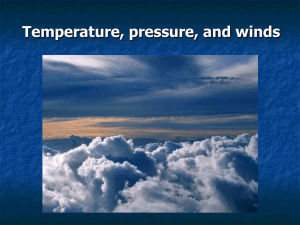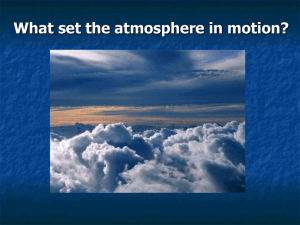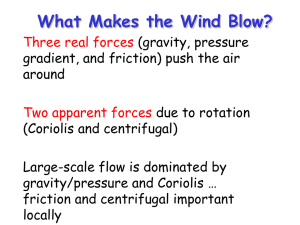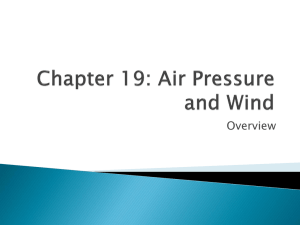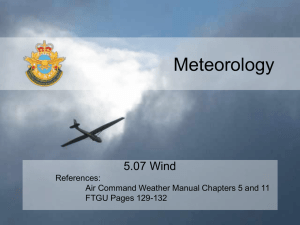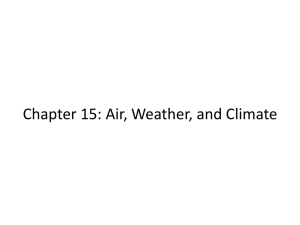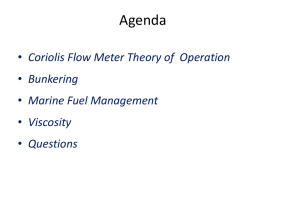CHAPTER 4. Atmospheric Pressure and Wind Chapter Overview
advertisement
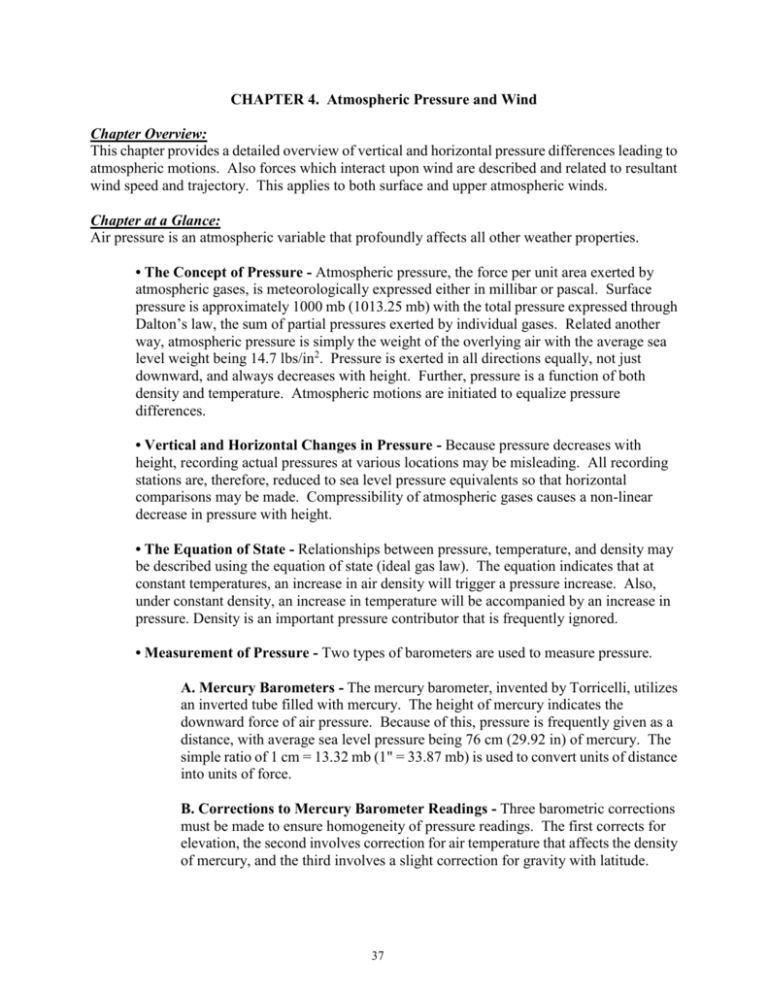
CHAPTER 4. Atmospheric Pressure and Wind
Chapter Overview:
This chapter provides a detailed overview of vertical and horizontal pressure differences leading to
atmospheric motions. Also forces which interact upon wind are described and related to resultant
wind speed and trajectory. This applies to both surface and upper atmospheric winds.
Chapter at a Glance:
Air pressure is an atmospheric variable that profoundly affects all other weather properties.
• The Concept of Pressure - Atmospheric pressure, the force per unit area exerted by
atmospheric gases, is meteorologically expressed either in millibar or pascal. Surface
pressure is approximately 1000 mb (1013.25 mb) with the total pressure expressed through
Dalton’s law, the sum of partial pressures exerted by individual gases. Related another
way, atmospheric pressure is simply the weight of the overlying air with the average sea
level weight being 14.7 lbs/in2. Pressure is exerted in all directions equally, not just
downward, and always decreases with height. Further, pressure is a function of both
density and temperature. Atmospheric motions are initiated to equalize pressure
differences.
• Vertical and Horizontal Changes in Pressure - Because pressure decreases with
height, recording actual pressures at various locations may be misleading. All recording
stations are, therefore, reduced to sea level pressure equivalents so that horizontal
comparisons may be made. Compressibility of atmospheric gases causes a non-linear
decrease in pressure with height.
• The Equation of State - Relationships between pressure, temperature, and density may
be described using the equation of state (ideal gas law). The equation indicates that at
constant temperatures, an increase in air density will trigger a pressure increase. Also,
under constant density, an increase in temperature will be accompanied by an increase in
pressure. Density is an important pressure contributor that is frequently ignored.
• Measurement of Pressure - Two types of barometers are used to measure pressure.
A. Mercury Barometers - The mercury barometer, invented by Torricelli, utilizes
an inverted tube filled with mercury. The height of mercury indicates the
downward force of air pressure. Because of this, pressure is frequently given as a
distance, with average sea level pressure being 76 cm (29.92 in) of mercury. The
simple ratio of 1 cm = 13.32 mb (1" = 33.87 mb) is used to convert units of distance
into units of force.
B. Corrections to Mercury Barometer Readings - Three barometric corrections
must be made to ensure homogeneity of pressure readings. The first corrects for
elevation, the second involves correction for air temperature that affects the density
of mercury, and the third involves a slight correction for gravity with latitude.
37
C. Aneroid Barometers - Aneroid barometers do not use fluids but rather rely
upon a collapsible chamber that compresses proportionally to air pressure. They
are simple and require only an initial adjustment for elevation. Barographs give
continuous readings from aneroid barometers through use of a rotating drum and a
plotting device.
• The Distribution of Pressure - It is useful to examine horizontal pressure differences
across geographic areas through pressure maps that depict isobars, lines of equal air
pressure. Through the analysis of isobaric charts, pressure gradients are apparent. Steep
pressure gradients are indicated by tightly spaced isobars while widely spaced isobars are
indicative of weak gradients. Air speed is proportional to pressure gradients.
A. Pressure Gradients - The pressure gradient force initiates the movement of
atmospheric mass, wind, from areas of higher pressure towards areas of lower
pressure. Horizontal wind speeds occur relative to the strength of the pressure
gradient. <CD6.4>
1. Horizontal Pressure Gradients - Typically, only small differences in
pressure exist across large spatial scales. Smaller scale weather features,
such as hurricanes and tornadoes, frequently display larger pressure
gradients across small areas. Still, relative to mean pressure, these
differences are nominal. <CD6.1>
2. Vertical Pressure Gradients - Average vertical pressure gradients are
usually greater than extreme examples of horizontal pressure gradients
stemming from the fact that pressure always decreases with altitude.
B. Hydrostatic Equilibrium - The downward force of gravity balances strong
vertical pressure gradients to create a hydrostatic equilibrium. The forces balance
such that air is held to the Earth’s surface. <Web> Local imbalances between the
two opposing forces initiate various up and downdrafts.
1. The Role of Density in Hydrostatic Equilibrium - Because
gravitational force is relative to mass, a dense atmosphere experiences
greater gravitational force than a less dense atmosphere. For the
atmosphere to remain in hydrostatic equilibrium, a vertical pressure
gradient must increase to offset increased gravitational force. Higher
temperature columns of air are less dense than cooler ones. For warm
(cold) air this equates to smaller (larger) vertical pressure gradients leading
to a hydrostatic equilibrium.
• Horizontal Pressure Gradients in the Upper Atmosphere - Due to density
considerations, pressure gradients in the upper atmosphere are best determined through the
heights of constant pressure. Constant pressure surfaces of colder air will be lower in
altitude than those of warmer air due to density differences. Height contours indicate the
pressure gradient such that closely (widely) spaced height contours indicate a steep
38
(shallow) pressure gradient and high (low) winds. Twice daily, heights are drawn at 60 m
intervals for heights at the 850, 700, 500, and 300 mb levels and are a useful tool for
forecasting. <CD6.4>
• Forces Affecting the Speed and Direction of the Wind - Given only the pressure
gradient force, wind will always move from areas of higher pressure to areas of lower
pressure. However, other forces influence the speed and direction of the resulting wind.
<CD6.2>
A. The Coriolis Force - Free moving objects in the atmosphere are influenced by
the rotation of Earth. <CD1.1> The resulting apparent deflective force, or Coriolis
Force (effect), causes two types of motion at the surface. The first is translational
movement, simply movement of an object from one place to another. Translational
movement is caused by the planet rotating about its axis and is proportional to
latitude. The second is the more important rotational motion, indicative of
vorticity. Rotational motion is also related to latitude such that it is maximized at
the poles and zero at the equator. <CD1.2> The Coriolis Force is an apparent force
as objects moving through the atmosphere may travel a straight path as seen from
space. <CD1.3> However, from a surface viewpoint, the object will veer to the
right in the N.H. and the left in the S.H. Coriolis deflection increases from zero at
the equator to a maximum at the poles. Also, the deflective force increases with
speed of the moving object. <CD1.4> Overall, the Coriolis force is rather weak so
that noticeable deflection takes place only on objects with long temporal motion
periods. Lastly, Coriolis deflection takes place regardless of the direction of
motion. <CD5.5> <Web>
B. Friction - Friction is a force of opposition and as such slows air in motion.
Frictional forces are initiated at the surface and extend aloft so that it is most
important for air contained within 1.5 km (1 mi) of the surface, the planetary
boundary layer (boundary layer). Because friction reduces wind speed it also
reduces the amount of Coriolis deflection as the Coriolis force is partially
dependent upon speed. The friction term is negligible above 1.5 km, the free
atmosphere. <CD6.8;6.9>
• Winds in the Upper Atmosphere - Upper air moving from areas of higher toward areas
of lower pressure undergoes Coriolis acceleration. Eventually, air will flow parallel to
height contours as the pressure gradient force balances with the Coriolis force. This
geostrophic flow (wind) may only occur in the free atmosphere. <CD6.6>
A. Supergeostrophic and Subgeostrophic Flow - Height contours and pressure
distributions are frequently curved, yet air in the free atmosphere remains parallel
to the isobars. This air is not truly geostrophic because it is constantly changing
direction. This gradient flow (wind) results from the pressure gradient force and
the Coriolis force being temporarily out of balance. This occurs around areas of
high pressure in supergeostrophic flow conditions when air undergoes rapid
acceleration and the Coriolis force dominates the pressure gradient force. When air
39
rotates counterclockwise around a low, subgeostrophic conditions predominate.
Here the pressure gradient force overpowers a weaker Coriolis force. Both
supergeostrophic and subgeostrophic conditions result in airflow parallel to curved
height contours. <Web> <CD6.6;6.7> <ME4.1>
• Near-Surface Winds - In near surface winds, friction must be considered. Because
friction slows air, the Coriolis force is weakened. This causes air to turn toward (away
from) areas of low (high) pressure and cross isobars at an angle. The resulting angle is
dictated by latitude and the total amount of friction present. <CD6.8;6.9>
• Cyclones, Anticyclones, Troughs, and Ridges - Global air pressure is typically divided
into a number of small-scale high and low pressure areas. <CD8.2> High pressure areas,
or anticyclones, have characteristic clockwise (N.H.) airflow (counterclockwise in the
S.H.). This occurs as air diverges from the high pressure area at the surface and is deflected
by Coriolis acceleration which turns the air to the right in the N.H. Opposite conditions
occur in relation to a cyclone, an area of low pressure and converging air at the surface.
Because air converges toward low pressure centers, cyclones are typically characterized by
ascending air which cools adiabatically to form clouds and possibly precipitation.
Anticyclones are characterized by descending air that adiabatically warms, contributing to
clear skies. In the upper atmosphere, ridges correspond to surface anticyclones while
troughs correspond to surface cyclones. <CD6.9>
• Measuring Wind - Wind direction always indicates the direction from which wind
blows. Azimuth indicates the degree of angle from due north moving clockwise from 0o to
360o. Wind vanes are devices that indicate wind direction while anemometers record wind
speed. An aerovane indicates both wind speed and direction. Similar devices attached to
balloons record wind conditions for the upper atmosphere.
Chapter Boxes:
4-1 Physical Principles: Velocity, Acceleration, Force, and Pressure - Speed, the
distance traveled per unit of time, is both related and dissimilar to velocity, which
incorporates both speed and direction. Acceleration, the change in velocity with respect to
time occurs when either speed or direction is changed. <CD6.2> Gravitational
acceleration is 9.8 m/sec/sec (32 ft/sec/sec) and is nearly constant everywhere on Earth.
Newton’s Second Law relates force to mass and acceleration such that the acceleration of
an object is proportional to the forces acting upon it and inversely proportional to its mass.
Despite nearly constant total atmospheric force, gases are not uniform across the planet.
Higher (lower) pressures occur where a greater (lesser) air mass exists.
4-2 Physical Principles: Variations in Density? - Air has a particular density and mass.
Changes in density affect many natural and anthropogenic phenomena. Density is given as
r = p/RT. Density is highly affected by temperature such that higher (lower) temperatures
induce a less (more) dense atmosphere. Humidity also plays a role in that adding water
vapor to air decreases density. This relates to the lower overall molecular weight of the
water molecule as opposed to the heavier dry air components of oxygen and nitrogen.
However, overall, the decrease in air density is only about 0.6% per 1% increase in water
40
vapor content.
4-3 Physical Principles: The Hydrostatic Equation - An atmosphere in hydrostatic
equilibrium exists when vertical pressure gradient forces balance gravitational force.
Further stated, pressure decreases with height equal to air density and the acceleration of
gravity. However, pressure decreases occur almost solely with decreases in density.
Because of this, pressure decreases more rapidly with height in cold, dense air than in
warm air. This principle is expressed quantitatively.
4-4 Physical Principles: The Coriolis Effect - Atmospheric motions are typically given
as compared to the rotating surface. Because the surface rotates, an object moving in a
straight line as viewed from space will travel a curved path when viewed from a surface
perspective. The magnitude of this “Coriolis force” is determined by the rate at which the
planet rotates (a constant), the speed of the object (across the surface) and the latitude. The
equation is expressed as Fc = 2 v sin w, where Fc is the Coriolis force, is the rotational
rate of Earth, v is the wind speed, and w is latitude. Combining this with Newton’s Second
Law which states that acceleration is force per unit mass, we see that Fc is an acceleration
as the equation gives Coriolis force per unit mass.
4-5 Physical Principles: The Equation of Motion - Horizontal pressure gradients dictate
that air flow from higher pressure areas toward lower pressure areas. In practice, this is
rarely the case as other forces interact upon moving air. The equation of motion
summarizes all three forces interacting on moving air. Thus, acceleration of air is
proportional to the pressure gradient force, Coriolis acceleration, and friction. The three
forces constantly interact with one another to determine resultant wind speed and direction.
4-6 Special Interest: Strong Winds and the Little Rock, Arkansas, Air Disaster - The
June 2, 1999 American Airlines airplane crash is detailed. Strong surface wind gusts (up to
140 km/hr {87 mph}) caused the crash that left 10 dead and 80 injured.
CD Rom Unit 5 - The Coriolis Force:
1. Introduction - The Unit begins with a brief discussion of wind traveling a
straight path relative to the stars, but a curved path relative to the Earth’s surface.
This, of course, is due to the fact that the surface is itself rotating along with Earth
rotation.
2. Rotation Around the Vertical - An animation details that the direction of
rotation for the N.H. as viewed from above the planet, is counterclockwise
(clockwise for the S.H.). Rotation rates vary with latitude as an animation depicts
through comparison of rotation at the poles and the equator. Graphics further
illustrate that although a polar position rotates, the equator does not as it lies
perpendicular to the axis of rotation. Rotation at other latitudes is expressed
through graphics that depict the angle relative to the rotation axis. Quantitatively,
the rotation rate is given as Earth rotation times the sine of latitude.
3. Rotation and Apparent Deflection - An animation shows a ball moving in a
straight path over a rotating surface. Although the path is straight, viewed from the
41
rotating surface, it travels in a curved path, an apparent deflection. This is similar
to winds moving across the planet and measured from the surface, a rotating frame
of reference. Similar graphics highlight these concepts for the S.H. Animations
also depict the flight of an object over a non-rotation and a rotating Earth to further
illustrate the concept of apparent deflection.
4. Slow vs. Fast Wind - The amount of deflection not only depends on latitude but
also the speed of motion as well. An animation details this by using two balls
traveling at different speeds over a rotating surface. The faster ball shows more
deflection.
5. Arbitrary Motions - Coriolis Force appears for all motions regardless of
direction as demonstrated in the movie of many balls traversing a rotating surface.
No matter the direction of movement, all moving objects are deflected relative to a
rotating frame of reference.
CD Rom Unit 6 - Atmospheric Forces and Motion:
1. Introduction - The Unit begins by explaining that complex wind patterns typify
the atmosphere. Even though winds are highly variable both spatially and
temporally, only a few forces interact to cause them. Integrated of this concept is
most appropriate with the Chapter section, Horizontal Pressure Gradients.
2. Newton’s 2nd Law - Newton’s 2nd Law states that Force = mass x acceleration.
When force is applied to an object, the object is accelerated. Acceleration is the
rate of change in velocity (change in speed and/or direction) as depicted by an
animation showing force increasing the speed of an object. The object accelerates
only when force is applied, otherwise, its direction and speed remain constant. The
same applies for the opposite, negative acceleration. An animation shows that
forces may cause a change in direction as well. Speed will remain constant
although an acceleration occurs. Newton’s 2nd Law may be modified to include the
sum of multiple forces. Both the magnitude and direction of the forces must be
considered. An animation portrays multiple forces interacting to create a net force
different from the primary forces involved. Both net direction and speed are
changed due to these interactions. The Chapter sections on Forces Affecting the
Speed and Direction of Wind, and Chapter Box 7-1 detail these notions.
3. Equation of Motion - Three forces combine to create net atmospheric force: the
Pressure Gradient Force, the Coriolis Force, and Friction. The CD details this by
dividing Newton’s 2nd Law by mass to reveal the equation of motion: Acceleration
= (PGF + CF + F)/mass.
4. Pressure Gradient Force - A map showing an isobaric pattern is provided to
demonstrate wind movement from high to low pressure regions. A similar map of
geopotential heights demonstrates the concept for the upper atmosphere. Also, the
magnitude of wind is related to isobar spacing in these portrayals. This section
applies to multiple text sections detailing aspects of the PGF.
42
5. Coriolis Force - Deflection of wind to the right in the N.H. and the left in the
S.H. is stated. Also stated is the relationship between the amount of deflection,
latitude, and wind speed. Further elaboration is unnecessary given that Unit 5
covers the Coriolis Force in detail.
6. Geostrophic Flow - When friction is neglected, the wind equation simplifies to:
Acceleration = (PGF + CF)/mass. An animation shows that when the PGF is
uniform, wind in motion reaches geostrophic balance as the PGF and the CF negate
each other. This leads to a flow pattern parallel to the isobaric pattern. When air is
obstructed, air flow is temporally deflected and a balance of forces is no longer
attained. Wave-like oscillations are produced which become progressively smaller
as energy is transferred to other surrounding parcels until the energy is diminished.
Animations depict this.
7. Gradient Flow - When isobars are curved, parcels remain parallel to the isobars.
This is due to the PGF and CF being temporally out of balance but acceleration
taking place through changes in wind speed and direction. Animations fully cover
this concept, which applies to text sections detailing upper air flow characteristics.
8. Friction - With friction added (in the lowest 1-2 km), CF is diminished making a
balance of forces impossible. Wind, therefore, crosses isobars at an angle. The
angle is dependent on the relative magnitude of forces. Friction, which is
dependent on surface roughness, propagates aloft through small scale turbulent
motions. These concepts are expressed visually through appropriate animations
and are suitable to enhance text sections on friction and surface air flow
characteristics.
9. Combination of Forces - An interactive animation allows the magnitude of the
PGF and friction to be changed, resulting in various wind speeds and trajectories.
Another animation shows parcel movement and speeds through a profile of the
atmosphere from the surface to intermediate levels to the upper air. Finally,
animations depict wind flow into (out of) a low (high) pressure center. These
animations may be featured as a capstone demonstrating many concepts included
within the chapter.
Related Web Sites:
Hydrostatic Equation: http://burro.astr.cwru.edu/Academics/Astr221/lect09/hydrostat.html
Coriolis Force: www.heimbaugh.com/science.coriolis
Geostrophic Flow: http://pollux.geog.ucsb.edu/~joel/g110_w98/oh/oh98_09_03.html
Media Enrichment:
ME4.1 - Movie of changing wind patterns through five different atmospheric levels.
Key Terms:
pressure
equation of state/ideal gas law
hydrostatic equation subgeostrophic flow
43
pascal
millibar
kilopascal
barograph
isobar
speed
acceleration
gravity
mercury barometer
barometric pressure
aneroid barometer
planetary boundary layer
free atmosphere
pressure gradient
pressure gradient force
hydrostatic equilibrium
Coriolis force
friction
troughs
ridges
azimuth
wind vane
geostrophic flow
force
anticyclones
cyclones
Dalton’s law
sea level pressure
equation of motion
velocity
anemometer
supergeostrophic flow
Review Questions:
1. What is a partial pressure?
Each gas in the atmosphere exerts a certain pressure on the surrounding air. This is a
partial pressure.
2. What is Dalton’s law?
Dalton’s law states that atmospheric pressure is really a sum of all associated partial
pressures.
3. Why does pressure always decrease with altitude?
Because density decreases with altitude, pressure must as well.
4. What is the difference between surface pressure and sea level pressure?
Surface pressure is simply a recording of the actual pressure located at that site. This is
different from sea level pressure for any site located above sea level. For comparison
purposes, all pressures are mathematically reduced to sea level equivalents, which
eliminates elevation influences.
5. How do speed and velocity differ? How do force and pressure differ?
Speed is the distance traveled by an object in a particular mount of time. Velocity is similar
to speed but also includes direction. Both concepts are related to acceleration which is a
change in velocity with time.
Force is an object’s mass multiplied by acceleration. All forces interacting on an object
must be collectively considered. Pressure is force per unit area. Said another way, it
describes the collective amount of force on an object divided by a given surface area.
6. What are the equation of state and the hydrostatic equations, and what do they tell us?
The equation of state, or the ideal gas law, states that at constant temperature, increases in
air density will cause an increase in atmospheric pressure. This may be reversed such that
an increase in air temperature will cause an increase in air pressure given a constant
44
density. The hydrostatic equation describes a situation whereby the vertical pressure
gradient force, derived from air pressure decreasing with height from the surface aloft,
equals the opposing gravitational acceleration. Thus, the atmosphere is held within a
balance between two opposing forces, one pulling the atmosphere away from the surface,
the other toward the surface. The hydrostatic equation demonstrates this mathematically as
p/z = -g, where p equals the change in pressure, z equals the change in altitude, equals
density and g equals gravitational acceleration. Local imbalances in this hydrostatic
equilibrium are denoted by up- and downdrafts in storms, rising parcels, etc.
7 What two variables determine air pressure?
Temperature and gravity
8. Describe how mercury and aneroid barometers measure air pressure, and explain why
corrections need to be used for the observations made from one but not the other.
Mercury barometers utilize a liquid filled tube to measure atmospheric pressure. The
height of the liquid (mercury) in the tube is proportional to the downward force of air
pressure. Aneroid barometers use a collapsible chamber which compresses proportional to
air pressure. Aneroid barometers require only an initial adjustment for elevation whereas
mercury barometers require corrections for elevation and air temperature, which affects air
density. A final adjustment for variations of gravity with latitude must accompany
mercury barometers.
9. In what way is it misleading to express pressure in inches of mercury?
Pressure has no unit of length. The unit of length is a response of a particular substance to
a particular atmospheric pressure.
10. Explain the concept of hydrostatic equilibrium.
Hydrostatic equilibrium refers to the balance of gravitational force and the force induced
by vertical pressure gradients. The forces balance so that air remains held to the Earth’s
surface. Local imbalances in the forces lead to up- and downdrafts.
11. Explain how air temperature affects the vertical pressure gradient.
Higher temperature columns of air are less dense than cooler ones. For warm (cold) air,
this equates to smaller (larger) vertical pressure gradients leading to a hydrostatic
equilibrium.
12. Explain how the pressure gradient force, the Coriolis force, and friction determine the
movement of air in the free atmosphere and in the boundary layer.
The pressure gradient force dictates initial wind direction and speed. Wind direction is
always initially directed from areas of high pressure toward areas of low pressure. Wind
speed is dictated by the magnitude of the force. The greater the force, the faster the wind
45
moves. Coriolis force is a deflective force resulting from Earth spin. This force, which is
zero at the equator, increases latitudinally until a maximum is achieved at the poles. The
force causes wind to be deflected to the right (with your back to the wind) in the Northern
Hemisphere and the left in the Southern Hemisphere no matter the initial wind direction.
Further, the amount of deflection is proportional to wind speed and latitude. Friction is a
force of opposition. It is maximized at the surface and decreases with height. Because
friction decreases wind speed, it alters the deflection initiated by the Coriolis force.
13. Describe the roles (if any) that wind speed, latitude, and direction of motion have in
determining the magnitude of the Coriolis force.
Coriolis force deflection increases with an increase in both wind speed and/or latitude.
Direction of motion has no effect on the amount of Coriolis deflection.
14. What are geostrophic and gradient flow? Why do they not occur near the surface?
A geostrophic wind is one that is in balance between the pressure gradient force and the
Coriolis force. This only occurs in the upper atmosphere in the absence of friction. The
term applies to relatively straight wind flow along straight and parallel isobars. Because
the forces are in balance, air flow remains parallel to the isobars. Gradient flow refers to air
flow paralleling curved isobar trajectories. This represents a condition when the two
opposing forces are temporally out of balance. Neither condition occurs near the surface as
friction slows air within the planetary boundary layer. This decreases the strength of
Coriolis deflection such that the force cannot balance with the pressure gradient force.
15. What are supergeostrophic and subgeostrophic flows?
In the region of upper air ridges, air flow is faster than elsewhere as a larger Coriolis force
is required to keep the flow turning to the right. This situation, in which the Coriolis force
exceeds the pressure gradient force and causes air to turn, is called supergeostrophic flow.
In trough areas, the pressure gradient force dominates the Coriolis Force which turns air
poleward. The existence of a weaker Coriolis force demands that the wind flow more
slowly, which is called subgeostrophic.
16. Define the terms cyclone, anticyclone, trough and ridge.
A cyclone is a region of low pressure. It is characterized by air which converges towards
its center and rises. Due to the Coriolis force, in northern hemisphere low pressure cells
spin counterclockwise. An anticyclone is an area of high pressure. It is characterized by
air that is sinking through its center and diverging in all directions at the surface. In the
northern hemisphere, high pressure cells spin clockwise from Coriolis deflection. A
trough is an equatorward dip in the isobaric pattern while a ridge is a poleward bump.
Troughs are associated with areas of surface low pressure while ridges are characterized by
high surface pressures.
17. Briefly describe the movement of air around cyclones and anticyclones in the Northern and
46
Southern Hemispheres.
Because of the three forces that interact with wind trajectories, air flow out of high pressure
cells (anticyclones) is curved. This flow is clockwise in the Northern Hemisphere and
counterclockwise in the Southern Hemisphere. At the surface, air flows across the isobars
at some angle due to frictional force decreasing Coriolis force. In the upper air, in the
absence of friction, air flow spirals around the anticyclone without crossing the isobars.
Cyclones (lows) represent opposite conditions with regard to wind direction. Here, air
flow is counterclockwise around cyclones in the Northern Hemisphere and clockwise in
the Southern Hemisphere. Again, air flow crosses the isobars at the surface but remains
parallel aloft.
18. What do anemometers and aerovanes measure?
Wind speed and wind direction, respectively.
47
